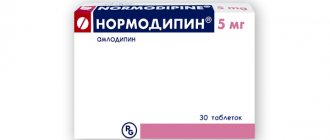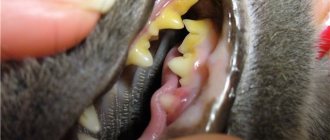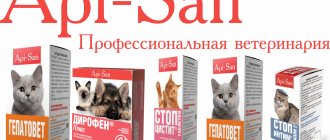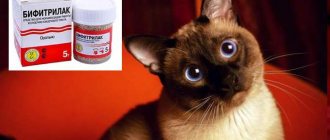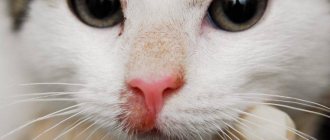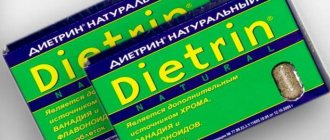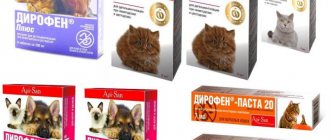Main characteristics of Flexoprofen
Flexoprofen is available only in the form of a clear or light yellow solution. Packaged in dark glass containers of 10, 50, 100 ml. 1 ml of the drug can contain 25 mg, 50 mg and 100 mg of the active substance (ketoprofen). The additional components included are:
- water;
- phenylcarbinol;
- lemon acid.
The shelf life of Flexoprofen is 36 months from the date of manufacture. The drug is kept in a closed bottle in a dry place at a temperature of 5 to 25 °C. During storage, precipitation in the form of small white crystals is allowed. This is not a sign of loss of properties of the medicine - you just need to shake the bottle well before use to dissolve the crystals.
It is better to buy Flexoprofen for cats in 10 ml bottles with a dosage of 2.5%
general description
"Flexoprofen" is an anti-inflammatory non-steroidal medicine, an injection solution available in three concentration variations - 2.5%, 5%, 10%. Accordingly, 1 ml of this product contains 25, 50 and 100 mg of ketoprofen. Auxiliary elements are citric acid, benzyl alcohol, L-arginine, distilled water for injection.
- 5.
- 10.
- 20.
- 30.
- 50.
- 100.
- 200.
- 250.
Each bottle in the Russian Federation must have a label with information in Russian:
- Manufacturer, its trademark and legal address.
- The name of the drug itself, the names of the active ingredients.
- Volume of the drug.
- Factory series, date of manufacture.
- Storage conditions.
- Shelf life.
- The inscriptions “For animals”, “Sterile”, “For injections”.
"Flexoprofen" for cats is supplied with instructions for use without fail.
- 10% drug (50 ml) - within 2020 rubles.
- 5% drug (50 ml) - within 800 rubles.
- 2.5% drug (10 ml) - within 300-500 rubles.
Indications for use
Preparations containing ketoprofen are prescribed for the treatment of inflammatory and degenerative diseases of the musculoskeletal system, including:
- rheumatoid arthritis;
- spondyloarthrosis;
- gouty arthritis;
- intervertebral hernia;
- osteoarthritis;
- extra-articular rheumatism (bursitis, capsulitis).
The drug provides symptomatic relief. For example, it has a pronounced antipyretic property and is prescribed to relieve pain of any origin, including in the postoperative period and after an animal has been injured.
Flexoprofen can be given to cats after surgery and to reduce post-traumatic pain
pharmachologic effect
The active component of the drug, as we have already mentioned, is ketaprofen. It has the following properties:
- Antipyretic.
- Anti-inflammatory.
- Painkiller.
According to the instructions and reviews of Flexoprofen for cats, the drug is successfully used to treat a whole range of inflammations - acute, chronic, subacute, accompanied by pain. The mechanism of action of ketaprofen is as follows: the substance disrupts metabolic processes with arachidonic acid, which in turn suppresses the formation of prostaglandins.
The instructions for Flexoprofen for cats indicate that the product is close to low-hazard (class 4 according to GOST 12.1.007-76). If the recommended dosage is followed, it does not have a sensitizing effect on the patient’s body.
The drug belongs to the non-steroidal anti-inflammatory group of drugs. The active component of the product promotes the production of propionic acid, which has an inhibitory effect on inflammation, relieves pain, and relieves fever. In the course of research, the product showed high effectiveness in the treatment of diseases with different etiologies (acute, subacute or chronic).
The medicine is used alone and in combination with other drugs. This provides a positive result in the fight against various diseases. Main indications: Chronic diseases of bone and cartilage tissue (arthritis/arthrosis). Hyperthermia. Swelling caused by bruises, dislocations. Acute colic. Pain syndrome (in case of injuries or in the postoperative period) .
How does Flexoprofen work?
Prostaglandins play an important role in the development of the inflammatory process, the occurrence of fever and pain. These are hormone-like substances synthesized by almost all tissues of the body and affecting the contraction of smooth muscles. Suppression of prostaglandin synthesis is the main task of ketoprofen, which is part of Flexoprofen.
Relief of pain and decrease in body temperature occurs after one dose of the drug (symptoms subside approximately 5 minutes after the injection, after 30 minutes the maximum concentration of the active substance in the plasma is reached). The therapeutic effect lasts 18–20 hours, then the substance is excreted by the kidneys. For a persistent anti-inflammatory effect, a course of medication is required (inject daily for 2–5 days, the duration of the course is determined by the veterinarian based on the diagnosis and general condition of the animal).
Medicinal properties
The main active ingredient ketoprofen is a secondary product of propionic acid, which belongs to the group of carboxylic acids, has therapeutic properties when affecting inflammation, pain and high temperature, therefore it is prescribed for the treatment of chronic diseases or those in an acute stage that cause attacks of severe pain.
Ketoprofen suppresses the synthesis of prostaglandins and thromboxane due to disruption of arachidonic acid metabolism. An intramuscular injection of ketoprofen allows one to achieve a macroconcentration of the analgesic in the blood plasma of patients half an hour after the injection. The ability of the drug to be absorbed in a living organism (bioavailability) ranges from 85 to 100% (it all depends on which animal the analgesic is administered). The body eliminates the substance through the kidneys.
Features of using the drug for cats
Flexoprofen is widely used in veterinary medicine, including for the treatment of cats. The animal body absorbs the drug well (bioavailability of active substances is 85–99%), side effects rarely occur when used correctly.
Selection of dosage
The dose of the drug depends on the weight of the cat: for every kilogram you need 2 mg of ketoprofen (the active substance, not the medicine). The concentration of the active substance is always indicated on the packaging (for example, if “2.5%” is written on the box and bottle label, this means that 1 ml of the drug contains 25 mg of ketoprofen).
Let's give an example of calculating the dosage for a cat weighing 6.25 kg. This animal requires 12.5 mg of active substance (6.25x2). For one injection, 0.5 ml of the drug is drawn into the syringe (this volume contains 12.5 mg of ketoprofen).
Treatment regimen
Flexoprofen injections should be given once a day. The drug is administered subcutaneously, intramuscularly or intravenously. The maximum duration of treatment for cats is 5 days (the duration depends on the goals of therapy - one injection is enough to relieve pain or eliminate fever; when treating joint pathologies, a full course is required).
Flexoprofen is administered subcutaneously, intramuscularly or intravenously
Video: how to give a cat a subcutaneous injection
Treatment of pregnant and lactating cats
Animals bearing cubs are injected with Flexoprofen only in the most extreme cases. The medicine can increase the muscle tone of the uterus and provoke premature labor. In addition, there is a risk that due to the cessation of prostaglandin synthesis, the ductus arteriosus in the fetus will close (which will lead to death or the birth of a kitten with pathologies of the cardiovascular system). A pregnant cat is given the drug only when the expected effect of the drug is more important than the potential threat to the fetus.
Flexoprofen is given to pregnant cats only if failure to treat with this drug is more dangerous than the risk of premature birth.
It is not recommended to inject animals with Flexoprofen before mating, as it reduces the permeability of eggs. The product is also not recommended for nursing cats, since 4–5% of the drug passes into breast milk. Flexoprofen is suitable for treating kittens from the first day of life, but with the most accurate dosage calculation.
Flexoprofen can be administered to kittens, but it is difficult to calculate the dosage yourself, given the small weight of the cub, so it is better to trust this matter to veterinarians
Precautionary measures
Do not allow Flexoprofen solution to get into your eyes. If you get the medicine on your hands, wash it off thoroughly with soap and water (the medicine does not corrode the skin, but you can accidentally rub your eyes, which will cause severe irritation of the mucous membrane).
Vials of Flexoprofen should be kept away from animals and children so that they do not accidentally open the product and drink it. You cannot place the drug in open sunlight or near a heat source - when heated, it loses its properties.
What to do in case of overdose
If a dose exceeding the norm is administered, the cat will experience symptoms of overdose:
- nausea;
- vomit;
- dizziness;
- weakness;
- diarrhea.
With a severe overdose, convulsions begin and blood pressure rises sharply. With such symptoms, the animal needs immediate help. Since there is no antidote for ketoprofen, you have to wait until the effect of the substance wears off (70% is eliminated after 6–7 hours, 80–90% after 24 hours).
Until the cat’s body is cleared of the medicine, it must be provided with symptomatic assistance by administering drugs that normalize the functioning of the cardiovascular, respiratory, and digestive systems.
Precautionary measures
When using Flexoprofen, it is important to follow hygiene and safety rules. When working with this medicine, it is prohibited:
- smoke;
- eat food, drink drinks;
- do not allow the medication to come into contact with the eyes, skin or mucous membranes (the affected areas should be rinsed for a long time with plenty of running water);
- use empty solution bottles for household purposes (they must be disposed of along with other waste).
If allergic reactions develop to contact with the drug, you must seek help from a doctor as soon as possible. It is advisable to have the medicine label or instructions for use of the solution with you.
When prescribing injections, standard safety precautions for contact with veterinary solutions are observed. When using the drug, you must wear rubber gloves to avoid direct contact with the drug. If the product gets into your eyes or hands, rinse immediately with plenty of water, and if an allergic reaction occurs, seek medical help. Empty medication containers must be disposed of.
We suggest you familiarize yourself with: Chihuahua diseases symptoms. causes and treatment
After the procedure, you must carefully monitor the condition of the animal and at the first questionable symptoms, contact a veterinarian.
With the right approach and comprehensive treatment, the animal will feel better, but it should be remembered that unauthorized prescription of drugs can be disastrous for the pet, so all procedures must be coordinated with a veterinarian.
Possible side effects and contraindications
When treating with Flexoprofen, the following types of adverse reactions may occur:
- From the gastrointestinal tract: diarrhea;
- mild nausea;
- belching;
- flatulence;
- dry mouth (causing the animal to drink frequently).
- weakness;
If side effects are mild, you should not stop injecting the drug, especially since the course is short-lived. If the symptoms are severe, you should consult a veterinarian - the doctor will examine the patient and, if necessary, select another medicine.
Strict contraindications for the use of Flexoprofen are:
- hypersensitivity to the components of the drug;
- stomach and duodenal ulcers;
- disorders of the blood coagulation system;
- pathologies of the kidneys and liver.
Owner reviews
Valentina, owner of the spaniel:
“Due to a pinched nerve after jumping from a 1.5-meter height, the dog constantly squealed in pain. Flexoprofen injections relieved pain well. During the period of action of the medicine, the animal became active and cheerful. We found no side effects. A good product from a domestic manufacturer.”
Mikhail, boxer's owner:
“The dog started having problems with his joints. At first they tried to solve them with the help of the Chondrotron, but due to severe pain, Jack refused to even get up. The doctor prescribed painkillers. After 5 days of using the drug, the dog was running around the apartment again. The pain did not return, but the use of medications to support joint function continued for a long period.”
Analogues of Flexoprofen
Flexoprofen is a fairly common drug, sold at an affordable price (288 rubles for a solution of 2.5% 10 ml). But sometimes it is not available in pharmacies - then the product can be replaced with drugs of a similar effect.
Table: comparison of drugs with similar effects to Flexoprofen
| Name | Main active ingredient | Release form | Difference from Flexoprofen | approximate price |
| Ainil (Spain) | Ketoprofen 1 or 10% | Injection | Complete analogue of Flexoprofen. There is an option on sale with a 1% concentration of ketoprofen, which is convenient for treating small animals (including kittens). |
|
| Ketoquin (Russia) | Ketoprofen 1 or 10% | Injection | Available in a convenient concentration of 1% for treating small animals. An additional component in the composition - L-arginine - helps improve the regeneration of cartilage tissue and the composition of the interarticular fluid. |
|
| Loxicom (UK) | Meloxicam 0.05 and 0.15% | Suspension for oral administration | The oral method is more complicated than the injection method. Loxicom acts more slowly than Flexoprofen (due to the fact that the maximum concentration in plasma occurs after 4-6 hours). |
|
| Onsior (UK) | Robenacoxib 5, 6, 10, 20 mg | Pills | Due to the tablet form of the product, it is difficult to accurately calculate the dosage. The medicine is prohibited for animals weighing less than 2.5 kg. |
|
Photo gallery: Flexoprofen analogues
Ainil is a non-steroidal anti-inflammatory drug that has anti-inflammatory, analgesic and antipyretic effects.
Contraindications to the use of Ketoquin are individual hypersensitivity of the animal to the components of the drug, stomach and duodenal ulcers
Loxicom is an analgesic drug in the form of a suspension, which belongs to the group of non-steroidal drugs.
Onsior contains robenacoxib as an active ingredient
Reviews from veterinarians
Evgeniy Aleksandrovich, head physician of the veterinary clinic:
“Flexoprofen is a good domestic medicine. Its main advantage is its relative safety, although it sometimes causes side effects, like other drugs from the group of non-steroidal anti-inflammatory drugs. Personally, I rarely prescribe it; I usually use foreign medicines in practice, but among my colleagues many speak positively about it.”
Marina, veterinarian with 8 years of experience:
“The product relieves pain well, but I would not abuse its use. Has a negative effect on the gastrointestinal tract. Sometimes I use it because I consider it safe compared to other painkillers. In my practice, there have been cases of problems with the digestive system in dogs. It is important to calculate the dose correctly and avoid overdose.”
Dosage
Flexoprofen is available in different concentrations, so this fact should be taken into account when calculating the dose. 1 ml of 2.5% product contains 25 mg of active substance, which corresponds to an animal’s body weight of 12.5 kg. For a cat weighing 5 kg, you will need 0.4 ml of the drug. The medicine should be administered once a day. The injection method is determined by a specialist.
| Kind of animal | Method of administration | Dosage | Treatment regimen |
| Cats and dogs | Intravenous, intramuscular, subcutaneous | 2 mg ketoprofen per 1 kg of weight | Once a day for 1-5 days |
| Calves | Intravenous, intramuscular | 3 mg ketoprofen per 1 kg of weight | |
| Sports horses | Intravenously | 2.2 mg ketoprofen per 1 kg of weight |
We suggest you read: What is an effective medicine for cystitis in cats?
If the indicated dosages are observed, the use of the drug does not cause complications. An overdose leads to loss of appetite, vomiting, and diarrhea. In this case, stop treatment immediately. Avoid skipping injections - this may reduce the effectiveness of therapy. If the dose of the drug was not administered on time, you should not administer a double dose - just quickly return to your previous treatment regimen.
